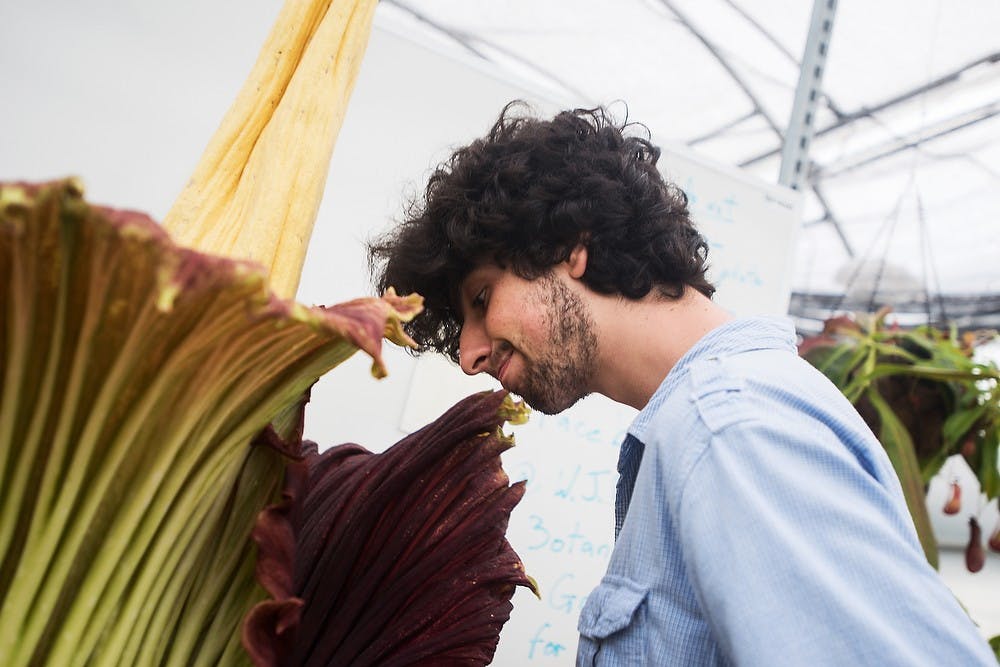By Sierra Lay
slay@statenews.com
THE STATE NEWS
Stationed in a small, tranquil and heated greenhouse on the corner of Wilson Road and Farm Lane, the corpse flower sits, rigged with a time-lapse camera in order to track the progress of its blooming. Peaking between Monday night and Tuesday morning, the flower attracted thousands to sample its putrid stench.
By 8:30 a.m. Tuesday, an extensive line had already begun to form and continued to grow throughout the day, even as intermittent rain forced staff to move the line into the sweltering greenhouse itself.
Greenhouse employees took steps to ensure the comfort of those waiting to see the flower.
Greenhouse Manager Dave Freville said the staff set up water checkpoints along the line when the sun came out and temperatures rose. They moved the line back outdoors when the heat in the greenhouse became too much, and led the elderly and handicapped to the front of the line as the wait time grew to a length of 2 1/2 hours.
Freville said staff was trying to get visitors through as quickly as possible, advising visitors to get their pictures with the flower and make their way out.
“We definitely were not prepared for this number (of people),” Freville said. “We’re not set up at this facility to have that many people.”
By 8:45 p.m. Tuesday, 45 minutes after the greenhouse was scheduled to close its doors, there were still approximately 400 patrons lined up outside. At day’s end, the corpse flower saw between 2,800 and 3,000 visitors.
Horticulturist Jan Szyren, who cares for all of the plants in the greenhouse was ecstatic to see such a large number of people interested in the plant.
“The best joy I get out of my job is sharing it with people,” Szyren said.
Szyren worked in the greenhouse when the corpse flower last bloomed. She has developed strategies which she believes encourage the flower to bloom.
“This time I kept the corm (bulb) extremely dry,” Szyren said. “I suspect that may have triggered the flowering.”
Social media played a large part in the numbers the greenhouse saw this year, officials said, including the W. J. Beal Botanical Garden’s Facebook page, where updates were constantly posted.
“The crowd was, I imagine, 10 times what we had four years ago,” Szyren said.
Freville attributed the large turnout to the plant’s promotion on social media, which was subsequently picked up by multiple media outlets.
“Ten years ago, they told us not to get on (social media),” Freville said. “Now they have classes on how to go about doing it to promote the university. It (has) changed completely.”
Freville said many children held their noses and squealed when they caught wind of the flower’s decay-like smell which the flower uses to attract flies and beetles, and elderly viewers seemed most impressed by it.
MSU alumna Grace O’Connor waited in line for over 1 1/2 hours to see the flower.
“I hope it’ll be worth it, but it might just be another plant,” O’Connor said.
Mason resident Joe Ranta, who stood in line for an hour with his family, said the wait was worthwhile.
“It only happens once every few years,” Ranta said. “We like things that stink.”
Curator of W. J. Beal Botanical Garden Frank Telewski said he was happy to see people become excited about plants.
“It’s a curiosity,” Telewski said. “It’s a thing that a lot of people will never have a chance in their life to see, and you have it right here in your backyard at Michigan State University.”
Botanical garden staff previously planned to pollinate the corpse flower with another flower blooming at Orange Coast College in Costa Mesa, California, but could not because the potential mate was blooming a day behind MSU’s. Instead, some of MSU’s corpse flower pollen was sent to Orange Coast College.
Telewski was able to perform artificial pollination on the hermaphroditic flower, and some visitors witnessed the process.
The corpse flower, a rarity even in its native habitat of the Indonesian island of Sumatra, was brought to MSU in 1995 and first bloomed in 2010. Staff said it is rare to have the flower bloom again in just four years.
Visitors can still see the flower Thursday from 10 a.m. to 2 p.m., though it is expected to be in decline by that time.
Managing Editor Simon Schuster contributed to this report.







